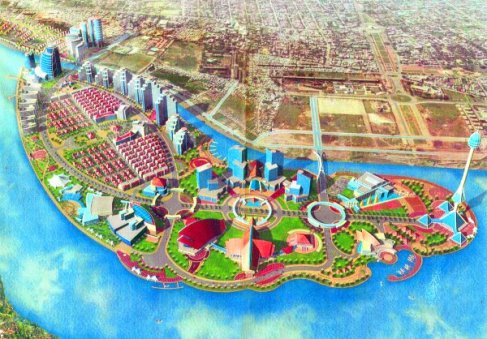Back Story:
- A water festival occurs every year to celebrate the reversal of the Tonle Sap River caused by the flooding and draining of the Mekong River. The Mekong feeds the Tonle Sap form November to May and May to November the Tonle Sap, “real agricultural heartland Camboida” drains into the Mekong.
- The festival lasts for 3 days and hosts nearly 3 million people. Phnom Penh has approx. 1.3 million inhabitants.
- November 22, 2010 a stampede resulted in the death of 350 people. The accumulation of spectators on the access bridge caused congestion that prevented movement for several hours. Panic attacks triggered a stamped in the crowd causing the death.
Resulted in:
- Questioning the role of public and private in the transformation of contemporary urban spaces in Phnom Penh, and the ability of developers to produce a sustainable city.
Point of his Research:
- Show that development of Phnom Penh from the early 1990’s is characterized by a withdrawal from urban planning and a multiplication of “urban projects” which determine in a particular the institutional relationship between private investors and stakeholders
- Use the example of Diamond Island to mention some major trends in the urbanization in Phnom Penh. Will show how the evolution of modern thinking on the city generated antagonism within urban politics today.
Thesis:
- Private investors for major projects do not sell urban spaces but an investment product.
- Internationalization of construction methods in Southeast Asia and Cambodia show that development in Phnom Penh since the 1990’s has been characterized by a withdrawal from urban planning and a multiplication of “urban projects” which determined in particular the institutional relationship between private investors and stakeholders.
Internationalization of Construction Methods and Generalization of “Urban Projects”
- Emergence of companies with an international dimension accelerates the transfer of urban models to the regional scale.
- These new dynamics launch questions about the relationship between urban planning and socioeconomic developments of these urban areas
- Globalization contributes to the transformation of urban areas but masks more complex local realities.
Urban Policies and Projects in Phnom Penh
- Started with Indochinese planning – which supports colonizing the country by building urban spaces and buildings that operate as a synthese between traditional local culture and a modern metropolis. (1910s)
- From independence in 1953, Phnom Penh was the subject of great works that illustrated the New National identity. This transformation of urban space was accompanied by an architectural thinking called New Khmer (an architectural movement during the 1950’s & 60’s. The style blended elements of the modern movement with 2 distinctly Cambodian traditions’ the grand tradition of Angkor, and the vernacular tradition of ordinary people’s houses.
- Takeover by the Khmer Rouge on April 17, 1975 marked a historical break in development.
- Signing of the Paris Accord on October 23, 1991 intended for a massive intervention by the international community to rebuild the country by incorporating it within the regional and international economy. This altered the construction of the urban areas
Institutional Fragmentation and Multiplication of Real Estate Projects
- 1990’s began large private construction projects, implemented by international institutions and nongovernment organizations.
- Since 2000 local political elites give priority to urban projects rather than urban planning.
New Methods of Construction of Urban Spaces in Phnom Penh
- OCIC (Overseas Cambodian Investment Corporation) became owner of Diamond Island in 2009
- The plan for the island (approved in 2006) consists of 100 acres of landscaped grounds with residential and commercial spaces, offices, conference halls and recreation spaces. It will provide an influx of 100,000 people per day up completion and 30,000 to 40,000 people living on the island in the residential portion called “Elite Tower”.
- Diamond Island serves as a major trend in the urbanization of Phnom Penh – private urban projects that emphasize urbanity as a sign of modernity as a destination of foreign and local populations.
City Marketing and Development of the Discourse of Modernity
- The modernization of Phnom Penh allows it to rise to the ranks of other regional capitals. Terms = “International City, “Sky Line” “World City”
- Used the incident at Diamond Island to highly publicize the need.
Make the City by Real Estate Investment
- Business is more important than building perennial urban spaces.
- Large private investors rely on the development of a new city-dwellers
- Return on investment will be greater if they adhere to the modernization of urban spaces, which will increase local demand, and therefore housing prices.
Conclusion:
- The historical development of construction methods illustrates a transformation of political and ideological manipulation of urban spaces in Phnom Pehn.
- 1863-1970 the city served to support the development of a national community. IN 1990 the state withdrew from urban planning and private players became the dominant players and main driving force behind the changing of the city.
- These private players rely on global urban modernity.
- Prevalence of politics over the technical, institutional fragmentation and the rule of motivations reveal the economic construction of the city’s local and global level to the elite economic and institutional to the townspeople.
- The New ways of building Phnom Penh’s urban spaces serve the private investors opposed to the local
- The drama of Diamond Island shows the risk of confusing the production of urban space with real estate investing, becoming the city and aggregation of “subprojects of consumption spaces” rather than “social space produced”

